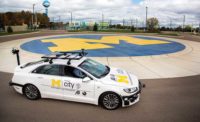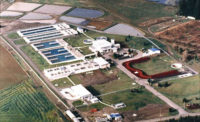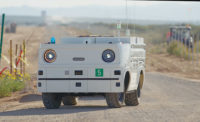A 32-acre, $6.5-million mini city at the University of Michigan looks like a film set, with building facades that mask empty interiors and vacant lots. But special attention is paid to the details of the infrastructure in this ghost town. Roadways and traffic signals look technologically advanced, with sensors and cameras that communicate with the cars on the streets. Upon closer inspection, the cars also are empty, whether stopping at a light or braking for a fake pedestrian. The city is a test bed to advance autonomous cars and smart infrastructure technology.
“The environment is a sandbox, and there are a few basic rules,” says Jim Sayer, deployment director at the University of Michigan's Mobility Transformation Center, nicknamed M-City, in Ann Arbor. “You can’t kick sand, but the sandbox is here, and it’s a safe environment.”
"Kicking sand" in this case means traffic accidents, an event researchers try to avoid at M-City. For example, proximity sensors are embedded into everything, from the vehicles and the traffic signals to the fake pedestrians they shove in front of moving vehicles.
“Our focus in the past was primarily the sensors in the vehicles,” says Sayer. “But the past three years, we’ve been moving to sensor technology in the infrastructure.”
These sensors include image processing for vehicle detection, which helps to control the signal phases on the traffic lights; these sensors also communicate with sensors in the cars. M-City is a smart test bed in which humans, infrastructure and vehicles are all talking via wireless signals and dedicated short-range radio communication to avoid running into one another. All these communications are labeled: vehicle to vehicle (V2V), vehicle to infrastructure (V2I) and vehicle to pedestrian (V2P). One of the most beneficial aspects of M-City is its location, right in the middle of Ann Arbor, says Sayer. In fact, Ann Arbor itself is installing infrastructure sensors throughout its streets to participate in the autonomous testing. “Ann Arbor has been doing that for four years now,” says Sayer. “When the engineers are ready to test in the real world, although cautiously, they just have to drive out of the gate into Ann Arbor—[it] is already wired up.”
Ann Arbor isn’t the only city to host test-bed autonomous vehicles. And it’s certainly not the largest.
The Contra Costa Transportation Authority (CCTA), Concord, Calif., worked with a naval base there to convert a seven-mile-long, 1.5-mile-wide mini city into a smart test bed, which it calls GoMentum Station. “Mercedes was our first partner, and Honda is now with us,” says Randy Iwasaki, executive director at CCTA. Honda plans to open a facility in Concord, just to be near the test bed, says Iwasaki.
“We have 5,000 acres with a seven-mile-long spine road, two 1,400-ft-long tunnels, bridges and undercrossings,” says Iwasaki. “We have barracks, a dentist’s office, a mess hall and giant parking lots for self-parking technologies. It’s about one-fifth the size of San Francisco.”
Iwasaki says he’s happy to work with M-City to move the ball forward on advancing autonomous vehicle technology.








Post a comment to this article
Report Abusive Comment